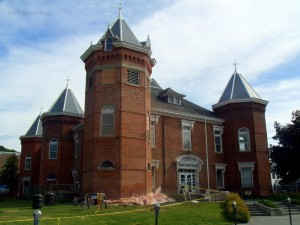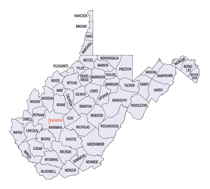West Virginia Counties
There are fifty-five counties in the state of West Virginia. Fifty of them existed at the time of the Wheeling Convention in 1861, before which West Virginia was part of the state of Virginia. The remaining five (Grant, Mineral, Lincoln, Summers and Mingo) were formed within the state after its admission to the United States on June 20, 1863. At that time, Berkeley County and Jefferson County, the two easternmost counties of West Virginia, refused to recognize their inclusion in the state. In March 1866, the US Congress passed a joint mandate assenting to their inclusion.Summers County, West Virginia
Summers County Education, Geography, and History

Summers County is a county located in the state of West Virginia. Based on the 2010 census, the population was 13,927. Its county seat is Hinton. The county was created by an act of the West Virginia Legislature on February 27, 1871 from parts of Fayette, Greenbrier, Mercer and Monroe counties and named in honor of George W. Summers (1804-1868)
Etymology - Origin of Summers County Name
In honor of George W. Summers, a prominent jurist of Kanawha County
Demographics:
County QuickFacts: CensusBureau Quick Facts
Early History of Summers County, West Virginia
Summers County was created by an act of the Virginia General Assembly on February 27, 1871 from parts of Fayette, Greenbrier, Mercer and Monroe counties. It was named in honor of George W. Summers (1804-1868).
George W. Summers was born on March 4, 1804 in Fayette County, Virginia. He was moved to the Kanawha Valley, near Clarksburg, by his parents when he was an infant. He graduated from Ohio University, studied the law and was admitted to the Virginia bar in 1827. In 1830, he was elected to the Virginia General Assembly and represented Kanawha County in the General Assembly from 1830 to 1840. He was elected as a Whig to the US House of Representatives and served there from 1841 to 1844. He was a member of the Virginia Constitutional Convention of 1850, ran for the Governorship of Virginia in 1850 but lost to Joseph Johnson, and was then elected Judge of the Eighteenth Judicial Circuit of Virginia, serving from 1852 to 1858. In 1861, he represented Kanawha County in the Virginia Convention that passed the Ordinance of Secession, which he opposed. He died in September 1868.
Colonel Abraham Wood became the first Englishman to explore the Summers County area when he traveled down the New River Valley in 1654. Christopher Gist passed through the county on his way home after exploring much of the present state of West Virginia on behalf of a land investment company, the Ohio Company, in 1750-1751.
Andrew Culbertson was the first English settler in present day Summers County. He moved into the present county in 1753 and his farm became known as Culbertson's Bottom. He abandoned the farm the following year after the Indians went on the warpath. His farm was then occupied and claimed by Thomas Farely.
After the county's formation, the county court was first held at the Baptist Church, two miles north of New River. The court was later moved to an office above C.L. Thompson's printing shop in Avis. That building burnt down in 1875 and the court moved to John Pack's storehouse on Hilton Island. A legal dispute then ensued between Dr. John Manser and E.B. Meader, who wanted the county seat at Foss, and Evan Hinton (called "Father of the County" due to his efforts to form the county) and his friends who wanted the county seat at Avis. The impasse over the location of the county seat was finally resolved when the Chesapeake & Ohio River Railroad Company donated three acres of land for county purposes, in the present site of Hinton, if the county seat was moved there. The county court house was constructed in Hinton in 1876 and occupied by the county court in 1877. Hinton has been the county seat since.
Hinton was laid out on the land of Avis Gwinn Hinton by her husband, John Hinton, in 1831. The town grew very slowly until 1871 when the Chesapeake & Ohio River Railroad company blasted a path through the New River gorge and made Hinton the division terminal. The town then started to grow and was incorporated on September 21, 1880. Some historians claim that the town was named for Evan Hinton, who was active in the movement to create Summers County. Others suggest that it was named for John (Jack) Hinton, who was a prominent lawyer in the county and laid out the town in 1831. In 1927, the towns of Avis, Bellepoint and Hinton were consolidated and incorporated as the city of Hinton by the West Virginia state legislature. From: West Virginia Heritage Encyclopedia, compiled by Hardesty.
Geography: Land and Water
As reported by the Census Bureau, the county has a total area of 368 square miles (950 km2), of which 360 square miles (930 km2) is land and 7.3 square miles (19 km2) (2.0%) is water.
Neighboring Counties
Bordering counties are as follows:
- Northeast: Greenbrier County
- Northwest: Raleigh County; Fayette County
- Southeast: Monroe County; Giles County, Va.
- Southwest: Mercer County
Education







